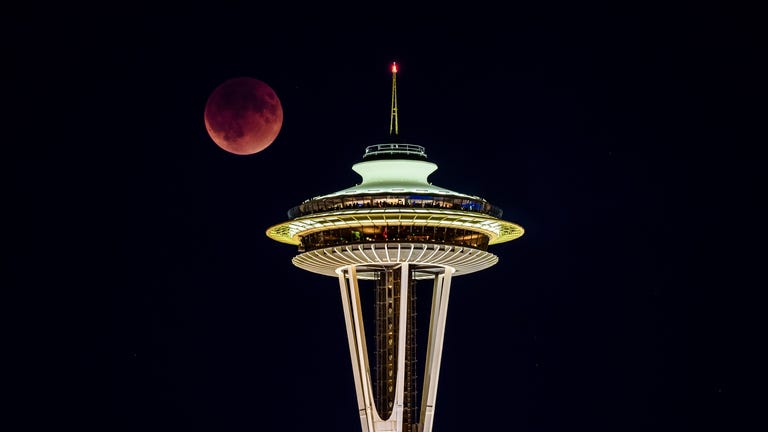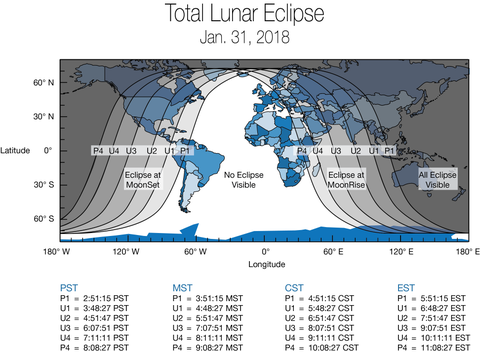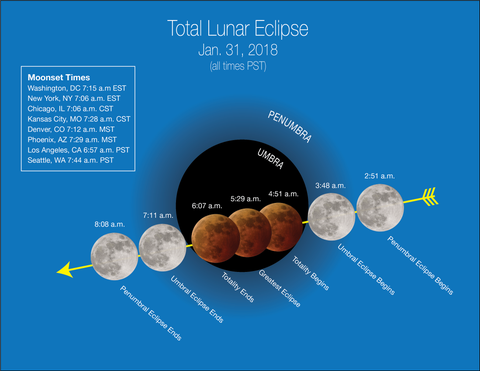The Most Spectacular Eclipse of 2018 Is In Less Than a Week
In North America, you'll need to be in the west to see the total lunar eclipse, which happens to coincide with a supermoon and a blue moon.
By Jay Bennett

TIM DURKAN
(Total lunar eclipse of a full moon at perigee, or a super blood moon, with the Seattle Space Needle, September 27, 2015.)
Once in a blue moon is only once every few years, but once in a super, blue, blood moon is just once every few decades. This rare alignment of three different lunar phenomena—a total lunar eclipse, a full moon at perigee, and a blue moon—will be visible in the night and early morning skies for much of the world on Wednesday, January 31.
During the total lunar eclipse, the moon will pass into the shadow of the Earth, blocked from direct sunlight by our planet, bathing Luna in a red glow that has led to the informal name of lunar eclipse totality: a blood moon.
"If you were out on the moon looking back at the Earth, you would see this beautiful red ring around the Earth," says Noah Petro, a lunar researcher with NASA. The light is red, says Petro, for the same reason that we see red sunrises and sunsets when the sun is low in the sky and its light is filtered through the atmosphere.
The total lunar eclipse will be visible in the western United States and Canada, Alaska, Hawaii, Australia, New Zealand, Japan, large parts of Russia and China, and parts of the Middle East. Totality, when the moon will be cast a blood red, begins at 4:52 a.m. PST, peaks at greatest eclipse at 5:30 a.m., and concludes at 6:08 a.m., spanning an hour and 16 minutes. Unfortunately in the eastern United States, the moon will set in the sky before the total eclipse begins. A partially eclipsed supermoon will be visible in the hours before dawn, but to see the blood moon you need to get west of the Rockies.

Global map showing areas of the world that will experience (weather permitting) the Jan. 31, 2018 "super blue blood moon." The eclipse will be visible before sunrise on Jan. 31 for those in North America, Alaska and Hawaii. For those in the Middle East, Asia, eastern Russia, Australia and New Zealand, the "super blue blood moon" can be seen during moonrise the morning of the 31st.
NASA
The total lunar eclipse also happens to coincide with a full moon at lunar perigee, or the point in the moon's orbit that brings it closest to the Earth. A full moon at perigee, which can be as much as 14 percent bigger and 30 percent brighter than at the farthest point (apogee), is informally known as a supermoon. (However, Petro says, a true supermoon, the closest and biggest it can get, is a full moon at perigee syzygy, which happens once during the 14 month lunar cycle. Perigee syzygy for 2018 already happened, on the January 2 supermoon.)
But the January 31 alignment of lunar phenomena doesn't stop there. The full moon on that date happens to be the second full moon of the month, or a blue moon. This astronomical occurance only occurs about once every two and a half years. However, 2018 is a unique year, and the solar and lunar calendars align so there will be another blue moon on March 31. (An alternate and older definition of a blue moon is the third full moon in a season that has four full moons.)
So on January 31, the world will be treated to a perigee blue moon total lunar eclipse. "The last time there was a celestial alignment of these three things was in 1982," says Petro. "But this is definitely the first time anyone has called it a super blue blood moon."

Stages of the Jan. 31, 2018 "super blue blood moon" (weather permitting) are depicted in Pacific Time with "moonset" times for major cities across the U.S., which affect how much of the event viewers will see. While viewers along the East Coast will see only the initial stages of the eclipse before moonset, those in the West and Hawaii will see most or all of the lunar eclipse phases before dawn.
NASA
The last super blue blood moon was the total lunar eclipse of December 30, 1982, though the last super blood moon, a total lunar eclipse at full moon perigee, occured on September 27, 2015. To see the upcoming eclipse, if you are west of the Pacific Ocean, you will need to rise before dawn, and east of the Pacific, you can watch the eclipsed moon rise into the late night and early morning after sunset.
The partial eclipse will span about three and a half hours, starting at 3:48 a.m. PST, and will be visible over much more of the world—a slightly darker and off-color supermoon. The total eclipse, however, begins when the moon moves entirely into the direct shadow of the Earth, called the umbra. When this happens, the only light that reaches the moon will be filtered through Earth's atmosphere, stripping out the blue wavelengths and casting the moon red.
There are no total solar eclipses this year, so this total lunar eclipse, which coincides with a supermoon and a blue moon, is truly the eclipse of the year. If it's not too late for you to get to the west (or to the east if you live in Asia), to where you can see the super blue blood moon, it will be well worth the effort.
Clear skies!
No comments:
Post a Comment